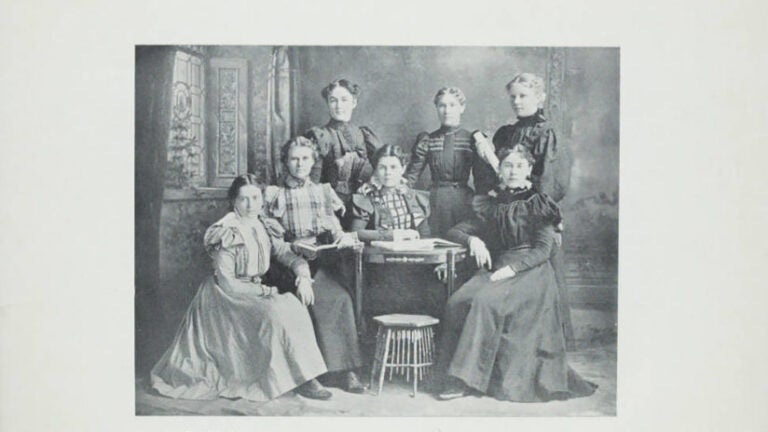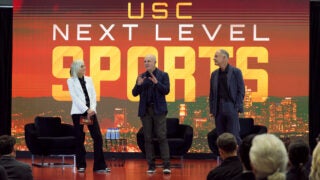
The women of Alpha Rho, one of USC’s early sororities, in the 1898 El Rodeo yearbook. (Photo/Courtesy of USC University Archives)
Women’s history at USC stretches back to the university’s beginnings
Women and women’s groups played a big role in USC’s early history — including supplying USC’s first valedictorian.
Women were always considered an important part of the educational configuration on campus, according to Southern California and Its University, a 1969 history written by Manuel P. Servín and Iris Higbie Wilson. The charter that created the university spelled out that it would be “open in every respect for the equal education of both sexes.”
This was a fairly progressive statement for the 1880s. Some universities feared “feminization,” believing that donors would shun institutions that admitted too many women.
USC administrators paid no attention to that. Thirty years before Congress gave women the right to vote, women made up a quarter of USC’s faculty. A group photograph of the first USC faculty shows three women among the original dozen professors. One of the three students who made up the Class of 1884 — USC’s first graduating class — was a woman. Defying stereotypes, two of the seven women who graduated in the Class of 1887 didn’t earn their degrees in the arts or humanities but in basic science. None of the men did.
In medicine, Elizabeth A. Follensbee, a professor of children’s diseases, served on the faculty in the College of Physicians and Surgeons. As early as 1886 — possibly inspired by Follensbee’s example – two women graduated from USC’s medical school. As early as 1909, women faculty taught at the College of Pharmacy, and three women graduated from the program in 1912. Women also served as early faculty in the School of Dentistry, which graduated two female students in 1918. One of them – Vada Somerville Watson – become the first black woman to be licensed to practice dentistry in California.
Women excelled in the classroom. Between 1897 to 1908, the university’s highest academic award — the Lottie Lane Prize, awarded to the senior with the best academic record — was awarded six out of 11 times to women.
A look at very early yearbooks also reveals women heavily represented in music and languages, subjects deemed more proper for ladies of the day. In 1899, the women dominated the School of Oratory. Out of eight faculty members, six were female – including the director, Maude E. Willis. Women gravitated to fine arts, too, joining professor William L. Judson on the Pasadena Arroyo’s grassy slopes, where USC’s art classes were held.
In later years, however, sororities in mathematics, commerce, self-government and journalism sprang up on campus, showing an ever broadening interest in careers once considered off limits.
In the university’s first year, the undergraduate literary society admitted both young men and women. But in its third year, a surprise came. The faculty decreed that the young men and women should be separated. To this day, the reasons remain unclear.
In those early years, athletics at USC — and at other universities — clearly favored male students with its emphasis on competitive sports. Women, however, did take part in “physical culture” classes. A photo in the 1910 El Rodeo shows long-skirted young women engaging in what looks like a game of softball, and later, tennis. In 1929, USC held an event to promote interest in women’s athletics. More than 50 “girls” participated in activities such as archery and fencing.
Most early student organizations and clubs had male presidents; females were usually relegated to such offices as secretary or treasurer. Even so, USC’s history abounds with women in leadership roles.
For example, a woman was on the staff that produced the first El Rodeo in 1898: Bertha Green was associate editor.
In 1884, Minnie C. Miltimore, was class valedictorian. She was also the first vice president of the Alumni Association of the College of Liberal Arts.
Early Trojan women found a particularly supportive atmosphere at the law school, which would come to be named the USC Gould School of Law. A dozen women students are listed in the 1900-01 yearbook.
The Legal Lights — a women’s law organization — was founded in 1911. The next year, it became Phi Delta Delta, the first women’s law sorority in the nation. By 1917, 42 women students had attended the law school, according Tom Tomlinson, an associate dean who has compiled a history of the school. In 1918, a female law student was senior class vice president. That same year, two of USC’s five postgraduate law students were women.
In 1913, the law school had the distinction of graduating the first woman deputy district attorney in the United States, Litta Bell Hibben. By 1918, Hibben was on the faculty.
May Lahey, a 1914 law graduate, served as an early Los Angeles judge. She was on the bench from 1929 to 1946. Another 1914 graduate, Georgia Bullock — a widow with two children — became the state’s first female judge in 1923. And Mabel Walker Willebrandt, who earned an L.L.B. in 1916 and an L.L.M. in 1917, went on to work at the Department of Justice in Washington, D.C., as assistant attorney general in the 1920s. Considered one of the nation’s most prominent women attorneys, she was responsible for enforcing prohibition.
By 1920, USC’s law school ranked third nationally in the number of women it had graduated, according to Tomlinson.
Women have had a firm footing at USC since its early days, and their involvement grew as the university matured. Today, the tradition continues.
A woman of the 1880’s
Even today, many college graduates cap off their education with a European tour. That’s what Alice Whitney did in 1884. The early Trojan, who attended USC in the 1880s, ended her studies by sailing to Europe, where she obtained some polish at a “finishing school.”
Whitney was typical of early Trojan women – entering the university when its student population was under 250 and its faculty numbered about a dozen.
She apparently didn’t complete four full years at USC – taking some courses at a nearby college that USC later absorbed.
While at finishing school, Whitney studied French, music, embroidery, cooking and sewing – subjects deemed necessary in the education of a young women. Whitney later reported on her European experiences to another USC alumna, Patsy Edwards, who befriended the older woman in the mid 1920s. From Edwards, we learn that Whitney never married, lived for a time in Germany after World War I and, after returning to California, devoted much of her adult life to caring for her ailing parents.
A devoted opera lover, Whitney coached Edwards in her spare time. For years, she managed her many rental properties in Hollywood. Born in the mid-1860s, Whitney lived into her 90s.
A woman of the 1920’s
Last fall, the Department of History caught up with its oldest living alumna — 94-year-old Blanche Wadleigh Bettington, a graduate of the Class of 1923. In her day, the department had just four faculty members. Bettington — who saw the construction of Bovard Administration Building — recalls that men and women students were equally represented at USC, though most women majored in teaching. She wanted to study law, but her parents steered her toward a teaching career, too. An independent thinker and early women’s rights activist, Bettington marched in suffrage parades early in the century.
A woman of the 1930’s
By attending USC, Jean Mustard Anderson followed in her parents’ footsteps – both were 1907 graduates of the medical school.
Her freshman year, Anderson and her roommates enjoyed campus life – ice skating at the Polar Palace and horseback riding in Griffith Park. She has memories of then-president Rufus B. von KleinSmid, “with all that white hair and walking very tall and straight.” She remembers being impressed with the recently dedicated Doheny Memorial Library. And she recalls going with friends to the Stanford/USC football game – by train.
She received her diploma in 1936.
“My major was history — not very good to get a job. But when you graduated [in the Depression], even Ph.D.s were digging ditches,” said Anderson, now 82.
She later returned to USC as an employee in the Registrar’s Office and the Employment Office. Anderson— a member of the Half-Century Club and a life member of Town and Gown — still likes to come to campus from time to time.
This story was updated in March 2021.



